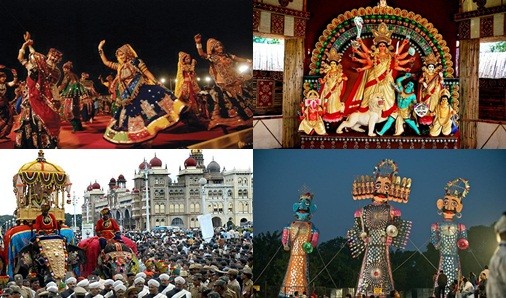Lesser Known Dussehra Celebrations

We all have read and heard about the different Dussehra celebration across the country. From Bommai Golu in Tamil Nadu to Mysore Durbar; from Delhi’s Ramlila to Bengal’s Durga Pooja; from Telangana’s Bathukamma to Dandiya and Garba of Gujarat. But Dussehra is not about these popular festivities. There is lot more celebrations and very unique, yet not popular ways of festival celebrations.
We look at few tribal regions and their very own celebrations of this grand festival. Being a harvest festival for most part of the country, tribals have their own way to acknowledge nature and mother Goddess. Interestingly, almost all the tribal communities in the country celebrate this festival with lots of pomp and vigour.
In Bastar, Chhattisgarh

In the Bastar region of Chhattisgarh, Dussehra is all about nature, spirituality and Devi Danteshwari, the local goddess. The festival is believed to have been started in the 15th century by Maharaj Purushaottam Deo, the 4th Kakatiya ruler of Bastar. It runs for 75 days and is often referred to as the longest festival in the world. A unique 75-day festival celebrated in the tribal heartland of Chhattisgarh. Unique rituals at this age-old tribal festival includes pata jatra (worship of wood), deri gadhai (posting of the pillars, kalash staphna (urn installation), kachan gaadi (throne installation for Devi Kachan), nisha jatra (nocturnal festival), muria durbar (conference of tribal chieftains) and on the last day, ohadi (farewell to deities).
All the region’s major tribes, brightly dressed in traditional attire, are involved. Some of the rituals and ceremonies are rather rigorous and unusual (a girl swinging on a bed of thorns, a youth buried shoulder-deep in a pit for nine days, and mediums possessed by the local deities roaming eerily on the roads), and there’s much energetic dancing and drumming. Numerous deities are brought from various parts of Bastar, and a massive chariot is pulled through the streets by more than 400 people as well.
In Kullu, Uttarakhand

At the centuries-old Kullu Dussera, spiritual fervour and ancient beliefs mingle harmoniously with the beats of dhadaks, the sonorous calls of Narsingha trumpets and the crisp Himalayan air.
On the first day, Goddess Hadimba is carried from the temple in Manali down to Kullu, where she’s taken to the palace and blessed by the royal family. She then goes to Dhalpur and is joined by the idol of Lord Raghunath (Lord Rama, the presiding deity).
Hundreds of gods and goddesses from all over the Valley come to meet them, and they’re carried in procession to Dhalpur Maidan where they stay until the end of the festival. The fair grounds are alive with exhibitions, cultural performances, and vendors from across India. On the last day, the chariot is pulled to the Beas River, where a pile of thorn bushes is set on fire to depict the burning of Lanka.
Over 200 local deities and demigods from neighbouring villages are brought to participate in Lord Raghunath’s rath yatra (a palanquin-chariot procession) to Dhalpur Maidan.
Started by Raja Jagat Singh (the erstwhile ruler of the Kullu valley) in 1637, the Kullu Dussehra is the only festival in India where such a large number of deities are assembled at one place. What also makes this festival unique is that unlike other places, the celebrations begin on Vijayadashami, the day when the Dussehra festivities end in the rest of the country.
In Kota, Rajasthan

Kota celebrates Dussera with a fun-filled mela (fair) that includes cultural performances, costume plays, spectacular displays of fireworks and a plethora of stalls serving delicious festive food. The tradition of organizing a Dussera fair (which runs for 25 days) is believed to have started in the reign of Maharaj Durjanshal Singh Hada in 1723 AD.
Artisans come from far and wide to sell their wares, and there are cultural programs and performances. Villagers also gather in traditional dress to offer prayers to Lord Rama and to celebrate his victory over Ravan. Towering effigies of Ravan are burned. In addition, there’s a captivating procession from the Royal Palace to the fair ground, featuring decorated elephants, camels, horses, folk dancers. The fair takes place alongside the Kota Adventure Festival, which is held on the Chambal River.
On Vijayadashami, massive effigies of Ravan, Meghnath and Kumbhakarna are set aflame to commemorate Ram’s victory over the demon king of Lanka. This is followed by a series of kavi sammelans, mushairas and moustache competitions!
In Madekeri, Karnataka

There are four temples dedicated to Goddess Mariamma (after whom the celebration is also called Mariamma festival), each having its own unique Karaga (a ritualistic folk dance dedicated to Draupadi) that is performed during the festival. However, the main amusement is the boisterous parade of 10 elaborately done up floats on which mechanical figures of gods, goddesses, demons and goblins enact dramas based on ancient plot lines.
A colourful, carnival-like festival celebrated amidst the serene hills of Coorg (Kodagu), Madikeri’s Dasara has a long and fascinating history that dates back to the reign of Haaleri Kings. There is nothing like jiving all night to foot-thumping music in the cool mountain air, with frequent breaks to sample spicy gobi manchurian, pandi curry and of course Coorgi coffee.
In Kulasekharapattinam, Tamil Nadu

Another unusual aspect of this festival is a trance dance in which pilgrims in fancy costumes sway to the pulsating beats of thara thappattam (with fire bearing clay pots in their hands) for hours on end and far into the night at Kulasekharapattinam in Tamil Nadu.
An ordinary coastal town, Kulasekharapattinam comes alive during its 10-day Dussera festival (also called Kulasai festival). Revolving around the Mutharamman Temple (an important pilgrimage spot in the region), the annual celebration is a melting pot of music, dance, drama and an astounding repertoire of colourful costumes.









